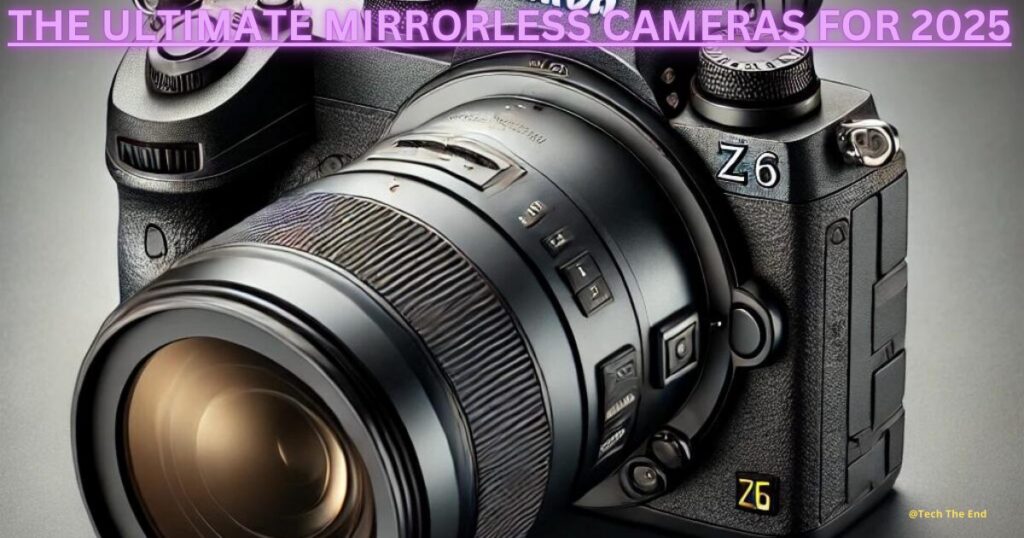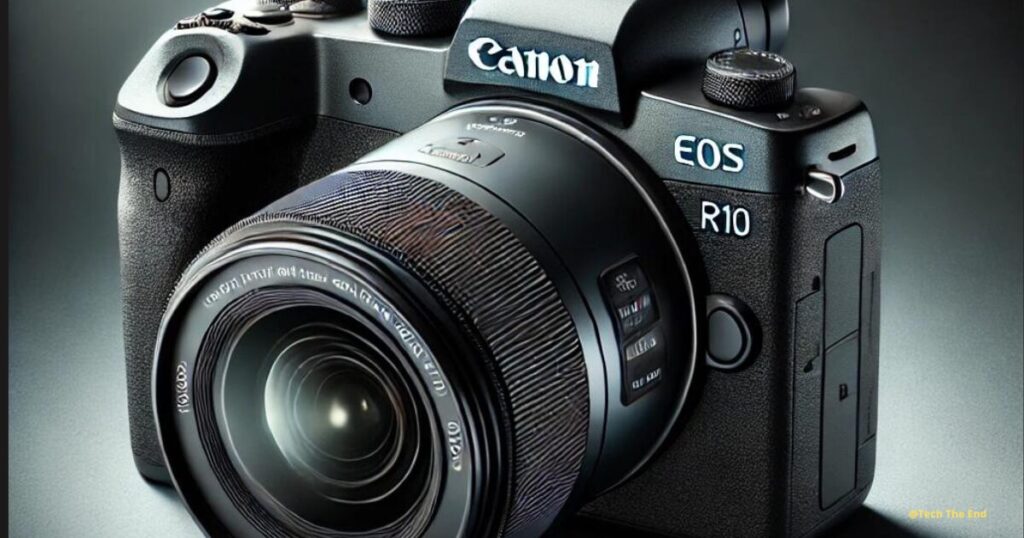1.The Nikon Z6 III-
The Nikon Z6 III – The Ultimate Mirrorless Cameras for 2025: Best Choices for Every Budget- is expected to be a significant upgrade from its predecessor, the Z6 II, bringing enhanced features to cater to both photographers and videographers. While official details are yet to be released, there are several anticipated improvements based on market trends and rumors. The Z6 III will likely feature an upgraded full-frame sensor in the 24-30 MP range, offering excelent img qualit, sharpness, and dynamic range while maintaining strong low-light performance. Powered by a newer generation EXPEED image processor, such as the rumored EXPEED 7, the camera is expected to deliver faster burst shooting speeds, possibly exceeding 14 frames per second, and improved noise handling at high ISOs. Autofocus is set to be another area of enhancement, with a higher number of focus points, better subject tracking, and more accurate eye and animal detection, especially in challenging lighting conditions or with fast-moving subjects.

For videographers, the Z6 III – is anticipated to support 4K UHD video at 60fps, with potential 6K or even 8K recording capabilities to compete with other mirrorless models in the market. The camera is likely to continue offering 10-bit internal video recording, along with Nikon’s N-Log profile, providing advanced color grading options. External recording options could include 12-bit RAW output via HDMI, making it a powerful tool for professional videographers. Like its predecessors, the Z6 III is expected to retain a durable, weather-sealed magnesium alloy body, with possible ergonomic improvements for better handling. Enhanced in-body image stabilization will likely be included to provide smoother video footage and better handheld shooting capabilities. Overall, the Nikon Z6 III is shaping up to be a robust, high-performance mirrorless camera, suitable for a wide range of creative professionals..
Sensor and Image Quality:–
A.Sensor: Likely an upgraded full-frame (FX-format) sensor, potentially sticking with the 24-30 MP range for a balance between resolution and low-light performance. There might be improvements in image sharpness and dynamic range.
ISO Range: Expected to improve or remain similar to the Z6 II, offering ISO 100-51,200, possibly with extended ranges to 204,800 or beyond for better low-light shooting.
B. Processing Power
Image Processor: An updated version of Nikon’s EXPEED processor, possibly EXPEED 7 or a newer generation, for faster image processing and improved noise reduction at high ISOs.
Speed: Enhanced burst shooting speeds—possibly over 14 frames per second (fps)—to cater to action photographers.
C. Autofocus System
Autofocus Points: The Z6 III is expected to see improvements in autofocus with a more refined, higher number of autofocus points and advanced subject tracking, similar to Nikon’s flagship Z9 camera.
Eye/Animal AF: Enhanced eye-detection autofocus for humans and animals, with better precision in challenging conditions like low light or fast-moving subjects.
2.Canon EOS R10-
There are cheaper mirrorless camera for beginners, but none that can match the versatility of the Canon EOS R10. From our tests, two features set the Canon EOS R10 apart for learners: its 15fps burst shooting rate and powerful subject-tracking autofocus, which operates across 651 AF points. These two features combine to make the R10 a fantastic performer in a range of scenarios, particularly when subjects are fast moving. We found it particularly good at tracking the eyes of subjects..

The Canon EOS R10 – is an entry-level mirrorless camera in Canon’s R-series, designed for enthusiasts and content creators who seek a balance between performance and portability. It features a 24.2 MP APS-C CMOS sensor, paired with Canon’s advanced DIGIC X image processor, delivering high-quality images with impressive detail and color. The camera offers an ISO range of 100-32,000 (expandable to 51,200, ensuring strong performance in low-light conditions. Its autofocus system, the Dual Pixel CMOS AF II, provides 651 autofocus points and covers a wide area of the frame, featuring eye-detection and subject tracking for humans, animals, and vehicles. With up to 15 fps burst shooting using the mechanical shutter and 23 fps with the electronic shutter, the R10 excels at capturing fast-moving subjects, making it ideal for sports, wildlife, & action photography.
For videographers, the Canon EOS R10 supports 4K UHD recording at 30fps, with oversampling from 6K for sharper details, and up to 60fps with a slight crop. Full HD (1080p) video at 120 fps is also available for smooth slow-motion footage. Dual Pixel AF II ensures smooth and precise autofocus during video recording, while the vari-angle 3-inch touchscreen makes it easy to shoot from different angles. Despite being compact and lightweight, the R10 features robust connectivity options, including Wi-Fi, Bluetooth, USB-C, and HDMI, as well as a microphone input for enhanced audio. Its 2.36 million-dot electronic viewfinder and the vari-angle LCD screen provide a flexible shooting experience, especially for vloggers or selfie shooters.
With its LP-E17 battery, the R10 can shoot around 430 images per charge, and its single UHS-II SD card slot ensures fast storage for photos and videos. Although it lacks in-body image stabilization (IBIS), the Canon EOS R10 offers excellent value with fast shooting, reliable autofocus, and solid video capabilities, making it an ideal camera for hobbyists, travelers, and budding content creators.
Sensor and Image Quality:
A.Sensor: 24.2 MP APS-C CMOS sensor
Image Processor: DIGIC X processor, the same processor found in Canon’s high-end models, allowing for fast performance and excellent image quality.
ISO Range: ISO 100-32,000 (expandable to 51,200), delivering solid low-light performance and noise control.
Autofocus and Shooting Speed
B. Autofocus System: Canon’s Dual Pixel CMOS AF II system, with 651 autofocus points covering a wide area of the frame. It features eye-detection and subject tracking, which works for humans, animals, and vehicles, making it highly versatile.
AF Speed and Accuracy: Known for its fast and accurate autofocus, especially in continuous shooting and video modes.
Burst Shooting: Up to 15 fps with the mechanical shutter and 23 fps with the electronic shutter, allowing for high-speed shooting, which is great for capturing action, sports, or wildlife.
Video Capabilities
C. Video Resolution: The Canon EOS R10 offers 4K UHD video recording at 30fps (oversampled from 6K for better detail) and up to 60fps in 4K with a slight crop. It also supports Full HD (1080p) video at 120fps for slow-motion recording.
Focus in Video: Dual Pixel AF II works in video, ensuring smooth and reliable focus tracking while filming.
HDR PQ: HDR recording options are also available for those looking to get more dynamic range in their videos.
Body and Design
D.Build: The EOS R10 is compact and lightweight, making it a great travel companion. It has a polycarbonate body with dust and moisture resistance, though it’s not fully weather-sealed like Canon’s higher-end models.
Viewfinder and Screen: It has a 2.36 million-dot electronic viewfinder (EVF) and a 3-inch vari-angle touchscreen LCD with 1.04 million dots, which can be flipped out for easy framing, particularly in vlogging or selfie modes.
3.Sony A7R V-
The Sony A7R V is a high-performance full-frame mirrorless camera that represents the fifth generation of Sony’s acclaimed A7R series. Tailored for professional photographers and advanced enthusiasts, it delivers outstanding image quality, fast performance, and a robust feature set ideal for a variety of photography styles, including landscape, portrait, and studio work.
a. Key Features and Specifications
Sensor and Image Quality Sensor: 61 MP full-frame Exmor R BSI CMOS sensor, offering exceptional detail and resolution, making it one of the highest-resolution sensors in the market.
Image Processor: Equipped with the latest BIONZ XR processor, which enhances processing speed, improves noise reduction, and allows for faster image capture.
ISO Range: ISO 100-32,000 (expandable to 50-102,400), providing great low-light performance and flexibility in various lighting conditions.
Autofocus and Shooting Speed
B. Autofocus System: Advanced 759-point hybrid autofocus system with real-time Eye AF for humans and animals, ensuring precise focus even in challenging situations.
Continuous Shooting: Up to 10 frames per second (fps) with the mechanical shutter and up to 20 fps with the electronic shutter, making it ideal for capturing fast-moving subjects.
Video Capabilities
C.Video Resolution: Supports 8K video recording at up to 24fps, 4K video recording up to 60fps, and 10-bit 4:2:2 internal recording, making it a versatile choice for filmmakers.
Focus in Video: Real-time Eye AF and subject tracking work in video mode, ensuring that subjects stay in focus while filming.
S-Log and HDR: Supports S-Log3 and HLG (Hybrid Log-Gamma) profiles for greater dynamic range and color grading flexibility.
Body and Design
D. Build: The A7R V features a durable magnesium alloy body that is weather-sealed to withstand challenging environments. Its ergonomic design provides a comfortable grip for extended shooting sessions.
Viewfinder and Screen: It boasts a high-resolution 9.44 million-dot electronic viewfinder and a 3.2-inch tilting touchscreen LCD with a high pixel density for easy framing and reviewing.
Connectivity and Ports
E. Ports: Includes a microphone input (3.5mm), headphone jack, USB-C port, HDMI output, and a multi-interface shoe for attaching accessories.
Wireless Features: Built-in Wi-Fi and Bluetooth allow for easy connectivity with smartphones and remote control capabilities via the Sony Imaging Edge app.
Battery and Storage
F. Battery Life: Uses the NP-FZ100 battery, offering approximately 530 shots per charge (CIPA rating) with the LCD screen.
Dual Card Slots: Supports dual memory card slots for both CFexpress Type A and SD UHS-II cards, providing flexibility and speed for high-resolution images and 8K video.
Additional Features
G Advanced AF Features: New focus modes, including a focus map for visualizing depth of field and an improved subject recognition algorithm for better tracking.
In-body Image Stabilization: 5-axis in-body stabilization compensates for camera shake, allowing for sharper images and smoother video.
Customizability: Highly customizable controls and menus allow users to tailor the camera to their shooting style.
4. Panasonic Lumix S5 II-
The Panasonic Lumix S5 II is a worthy successor to one of our favorite vdeo cameras, the S5. Like the S5, the S5 II is ticketed as a hybrid, but video is where it excels. In our tests, we found its 6K/30p footage rich ad detailed, with wide dynamic range. Its video chops are bolstered by 10-bit recording across almost all resolutions, plus the ability to record uncropped footage using the sensor’s full 3:2 aspect ratio – useful for cropping content. We also found it sturdy yet comfortable to handle during testing. Happily, its compact design doesn’t compromise the physical controls.
The S5 II is Panasonic’s first mirrorless camera with phase detection AF for video. Combined with effective image stabilization, we found it produces sharp, stable video even when shooting handheld, although the 1.5x crop on 4K/60p video is a shame. The Panasonic Lumix GH6 is a more travel-friendly video powerhouse with a Micro Four Thirds sensor, while serious videographers will be drawn by the Lumix S5 IIX. Nevertheless, the S5 II is a fantastic full-frame hybrid for high-quality videoz
5. Canon EOS R7-
The Canon EOS R7 is like one of the camra giant’s full-frame EOS R cameras, only with a smaller APS-C sensor. For the price, it’s impressively powerful, particularly if you’re fan of shooting wildlife or sports scenes. That’s because it boasts 15fps burst speeds (or 30fps if you switch to the electronic shutter). Our tests found that the EOS R7 can indeed hit these speeds, though you don’t get the deep buffers found on full-frame siblings like the EOS R6, so it can’t sustain those speeds for quite as long.
Beyond rattling off frames of speeding animals, the EOS R7 offers comfortable handling, Canon’s latest subject-tracking autofocus system and and dual UHS-II card slots, making it a camera that will also tempt pro EOS R series fans as a second body. The only downside? Canon has so far only made two native lenses for the EOS R7’s APS-C sensor. More should be en route, though, and you can always mount existing RF lenses or adapt older EF lenses from Canon’s DSLRs while you wait.
5.The Canon EOS R7 is like one of the camera giant’s full-frame EOS R cameras, only with a smaller APS-C sensor. For the price, it’s impressively powerful, particularly if you’re fan of shooting wildlife or sports scenes. That’s because it boasts 15fps burst speeds (or 30fps if you switch to the electronic shutter). Our tests found that the EOS R7 can indeed hit these speeds, though you don’t get the deep buffers found on full-frame siblings like the EOS R6, so it can’t sustain those speeds for quite as long.
Beyond rattling off frames of speeding animals, the EOS R7 offers comfortable handling, Canon’s latest subject-tracking autofocus system and and dual UHS-II card slots, making it a camera that will also tempt pro EOS R series fans as a second body. The only downside? Canon has so far only made two native lenses for the EOS R7’s APS-C sensor. More should be en route, though, and you can always mount existing RF lenses or adapt older EF lenses from Canon’s DSLRs while you wait.
A. -Sensor and Image QualitySensor: 32.5 MP APS-C CMOS sensor, providing high-resolution images with excellent detail and color reproduction.
Image Processor: Equipped with the DIGIC X image processor, which enhances overall performance, including faster processing speeds and improved noise reduction, especially at higher ISOs.
ISO Range: ISO 100-32,000 (expandable to 51,200), allowing for strong low-light performance and versatility in various lighting conditions.
B.Autofocus System – Autofocus Points:- Utilizes Canon’s Dual Pixel CMOS AF II system, featuring 651 AF points for fast and precise focusing across a wide area of the frame.
Advanced AF Features: The camera includes eye-detection AF for humans and animals, along with subject tracking capabilities, making it ideal for dynamic shooting scenarios.
Shooting Speed
C.Continuous Shooting:- The EOS R7 can shoot at up to 15 fps with the mechanical shutter and 30 fps with the electronic shutter, making it suitable for capturing fast-moving subjects in sports and wildlife photography.
Video Capabilities
D.Video Resolution: The R7 supports 4K UHD recording up to 60 fps and Full HD recording at 120 fps for slow-motion effects. It utilizes oversampling from 7K for sharper 4K footage.
Video Features: It offers Canon Log 3 and HDR PQ options for enhanced dynamic range and color grading flexibility, catering to professional videographers.
Body Design and Handling
E Build:- The camera features a compact and lightweight design with weather-sealing, allowing for durability in challenging shooting environments.
Viewfinder and LCD:- It includes a high-resolution 2.36 million-dot electronic viewfinder (EVF) and a 3-inch vari-angle touchscreen LCD that makes it easy to shoot from various angles, particularly useful for vlogging.
rajyamarathinews…………..






